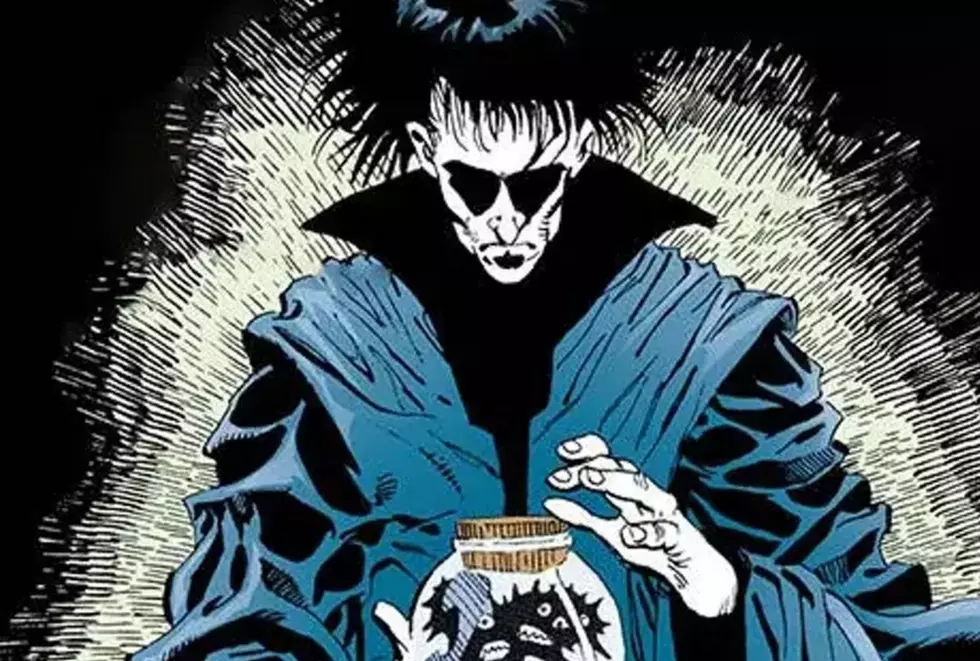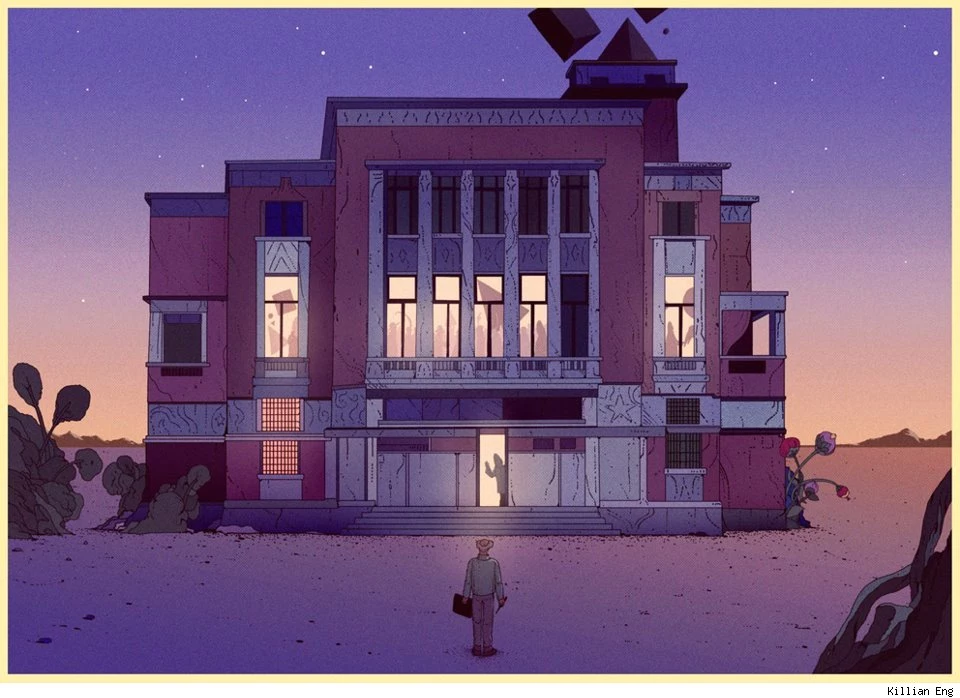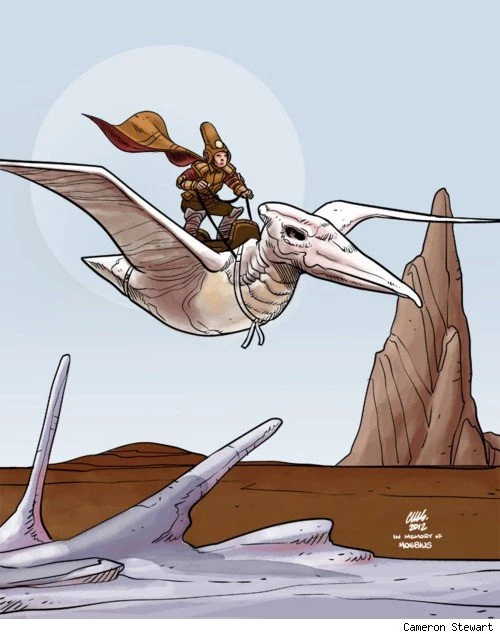
The Comics Community Pays Tribute to Jean ‘Moebius’ Giraud in Words and Pictures

It's been about one week since we said goodbye to the great comic book master Jean Girard, who passed away at age 73 after a long struggle with cancer. Better known around the world as Moebius, Giraud had an immeasurably massive influence on the realms of cartooning, illustration and even film. Naturally the tributes to his legacy have been legion, particularly in the comic book community where he was most revered. Some of these tributes have taken the form of personal essays on what Moebius' work meant to them, reverent obituaries and original illustrations inspired by his legendary work. We've collected some below.Batman: Death By Design artist Dave Taylor has published some wonderful anecdotes about his personal interactions with Moebius. Here's just one:
I was due to be in Paris so called [Giraud] at his home there. He welcomed me in with a huge bowl of tea and sat me down saying "could I show you what I've been working on?" He disappeared into his studio, which I was craning my neck to look into, and emerged like an embarrassed child clutching a half finished page of Blueberry. I took it. He stood away, looking to catch my thoughts as I looked over it. What struck me wasn't so much the beautifully crafted page of art, perfect and unique as it was, but the attitude he had. I was an equal, a fellow artist who's thoughts and impressions meant a great deal to him. I shrugged, smiled up at him and said "Beautiful!" to which his response was so humble and honest that the moment stayed with me to this day.
Frank Quitely is recognized as one of Moebius' most popular stylistic descendants in mainstream American comics, as evidenced by his in work All-Star Superman and New X-Men, among others. The artist at Dangerous Minds about Giraud's unmatched technique. An excerpt:
Everything that makes his designs, comic covers, illustrations and individual drawings and paintings beautiful, striking, well composed and effectively realized, is also employed in his strip-work. The ability to make not just a collection of wonderful images, but to make those images work together in sequence, is a whole other art-form in itself, and Moebius excelled as much in the fluidity of his storytelling as he did in the brilliance of his linework.
As a teenager, The Sandman writer Neil Gaiman was profoundly influenced by the original French editions of Métal Hurlant, the science fiction magazine Moebius co-founded.
I read the magazine over and over and envied the French because they had everything I dreamed of in comics - beautifully drawn, visionary and literate comics, for adults. I just wished my French was better, so I could understand the stories (which I knew would be amazing).
I wanted to make comics like that when I grew up.
I finally read the Moebius stories in that Metal Hurlant when I was in my 20s, in translation, and discovered that they weren't actually brilliant stories. More like stream-of-consciousness art meets Ionesco absurdism. The literary depth and brilliance of the stories had all been in my head. Didn't matter. The damage had long since been done.
ComicsAlliance contributor Matt Seneca wrote beautifully about Moebius' transcendent work. An excerpt:
Moebius is more than his stories, more even than the specifics of what his images depict. Those colors, those marks, those rounded and expressive forms, touch something very deep in people. I've thought it through for the better part of a decade, and my best guess is this. Moebius fused all the hallmarks of genre comics -- intricate spaceships, ancient monoliths, monstrous creatures, superpowered demigods, beautiful maidens, unexplored landscapes -- to lines that made every surface look a bit aged, a bit used, long since gone over by multitudes of human hands or feet, and to colors so bright and crystalline that every panel seems ripe to be reached into and touched. He presented the worlds of fantasy and escape that comics readers across the globe have lived their whole lives in, not as we've seen them elsewhere, but as we imagine them -- scuffed up and worn around the edges from the time we've spent inside them, but still forever shining with the promise of new wonders yet to come.
In his very personal eulogy for Moebius, Sean Witzke wrote about the artist's indelible influence on popular culture:
No artist, let alone a comics artist, has been as singularly influential on the way we as a species see ourselves moving forward. For good or ill, since Moebius, and his contemporaries, imagined what we now think of as the modern urbanized city (or the cyberpunk city), we couldn't have conceived of it. While that idea has many, many precedents, none of them ring as true. None of them are still relevant. Not one of them captures what city blocks teeming with dozens of kinds of people all together in one space. Walls of faces, some alien, all familiar. None have the locations and trappings of "the future" as used, lived-in. Science fiction in the past 30 years is indelibly linked to Moebius, he is everywhere you look.
At The Comics Reporter, Tom Spurgeon wrote a short biography of Moebius that included this passage about the artist's success outside his native France:
Giraud was rare among his similarly heavy-hitting French comics peers in that he was frequently published in North America. He even enjoyed a unique relationship with Marvel Comics, better known for exploiting its own properties than working with artists on books revolving around their names and concepts. He drew a two-issue Silver Surfer mini-series scripted by Stan Lee that appeared in 1988 and 1989 -- at which time the artist had moved to Los Angeles -- and made a popular series of single-image drawings of Marvel characters. Marvel's Epic imprint published a series of their album-sized "graphic novels" featuring Moebius' work from about 1987 to 1992, one of the stalwart projects of the Direct Market's initial infatuation with the graphic novel format. Because of that market's sometimes-narrow range of interests, that a stylish artist like Giraud had any work featured at all let alone by a market giant like Marvel made him an important influence on the next wave of comics-makers, just as the wild Metal Hurlant work had inspired a generation before them.
Most comprehensive of all may be this thorough obituary written by Kim Thompson at The Comics Journal, organizing Giraud's career chronologically. A portion about the creation of Métal Hurlant:
And so the "Moebius" signature made its reappearance in L'Écho (in the story "White Nightmare"), and soon Giraud joined his friends Druillet and Dionnet, as well as a fourth founder Bernard Farkas, to create the similarly-formatted adult science fiction comic Métal Hurlant (and along with it its publishing arm, Les Humanoïdes Associés). For the rest of the 1970s, Giraud would divert much of his focus from "Blueberry" (which was still running in Pilote regardless of the Goscinny dust-up - in part because the series' substantial royalties funded Giraud's far less profitable alternative work) to focus on an astonishing run of wildly inventive series and stories for Métal, including the stunningly-colored, wordless surrealistic fantasy series "Arzach" and the whimsically disjointed, Michael Moorcock-inspired "Garage Hermétique de Jerry Cornelius," both of which premiered, to the delight and frequent bafflement of readers, in the first issue of Métal.
Additionally, The Comics Journal has a growing collection of creator tributes to Moebius, including heartfelt testimonies by Paul Pope, Michael Allred and John Workman that we encourage you to check out.
On his Quenched Consciousness blog, cartoonist Ian MacEwan has been creating a timeline of Moebius' career that is full of beautiful images and useful information.
Finally, the artwork. As made plain in all of these writings, Giraud was an important force in the lives of people who experienced his work in comics and illustration or through the film and other science fiction/fantasy work he fathered with his influence. Some of them became artists themselves:



More From ComicsAlliance


![The Autobiography Of Loma: ‘Shade The Changing Girl’ #7 [Exclusive]](http://townsquare.media/site/622/files/2017/03/STCG_Cv7_featured.jpg?w=980&q=75)





















